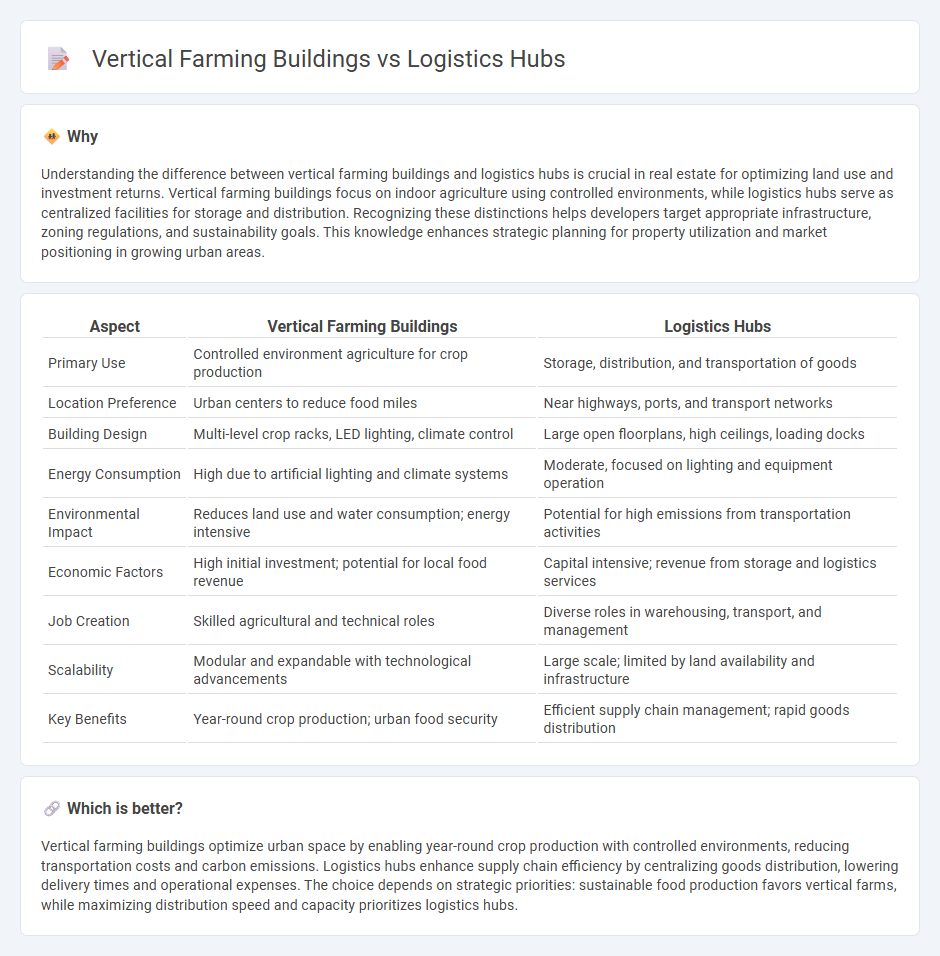
Vertical farming buildings maximize urban space by integrating advanced hydroponic systems and sustainable energy solutions, resulting in higher crop yields and reduced transportation costs. Logistics hubs optimize supply chain efficiency through centralized storage, rapid distribution, and state-of-the-art inventory management technologies. Discover how these real estate models are revolutionizing urban infrastructure and sustainability strategies.
Why it is important
Understanding the difference between vertical farming buildings and logistics hubs is crucial in real estate for optimizing land use and investment returns. Vertical farming buildings focus on indoor agriculture using controlled environments, while logistics hubs serve as centralized facilities for storage and distribution. Recognizing these distinctions helps developers target appropriate infrastructure, zoning regulations, and sustainability goals. This knowledge enhances strategic planning for property utilization and market positioning in growing urban areas.
Comparison Table
| Aspect | Vertical Farming Buildings | Logistics Hubs |
|---|---|---|
| Primary Use | Controlled environment agriculture for crop production | Storage, distribution, and transportation of goods |
| Location Preference | Urban centers to reduce food miles | Near highways, ports, and transport networks |
| Building Design | Multi-level crop racks, LED lighting, climate control | Large open floorplans, high ceilings, loading docks |
| Energy Consumption | High due to artificial lighting and climate systems | Moderate, focused on lighting and equipment operation |
| Environmental Impact | Reduces land use and water consumption; energy intensive | Potential for high emissions from transportation activities |
| Economic Factors | High initial investment; potential for local food revenue | Capital intensive; revenue from storage and logistics services |
| Job Creation | Skilled agricultural and technical roles | Diverse roles in warehousing, transport, and management |
| Scalability | Modular and expandable with technological advancements | Large scale; limited by land availability and infrastructure |
| Key Benefits | Year-round crop production; urban food security | Efficient supply chain management; rapid goods distribution |
Which is better?
Vertical farming buildings optimize urban space by enabling year-round crop production with controlled environments, reducing transportation costs and carbon emissions. Logistics hubs enhance supply chain efficiency by centralizing goods distribution, lowering delivery times and operational expenses. The choice depends on strategic priorities: sustainable food production favors vertical farms, while maximizing distribution speed and capacity prioritizes logistics hubs.
Connection
Vertical farming buildings and logistics hubs are interconnected through efficient supply chain management, enabling rapid distribution of fresh produce from urban farms directly to consumers and retailers. Integrating vertical farms within or near logistics hubs minimizes transportation costs and reduces delivery times, supporting sustainable urban food systems. This synergy enhances real estate value by promoting mixed-use developments that combine agricultural innovation with efficient logistics infrastructure.
Key Terms
Location
Logistics hubs are strategically located near major transportation networks such as highways, ports, and airports to optimize supply chain efficiency and reduce delivery times. Vertical farming buildings prioritize proximity to urban centers to ensure fresh produce supply, minimize transportation costs, and lower carbon footprints. Explore the distinct location strategies of these facilities to understand their impact on operational effectiveness and sustainability.
Zoning
Zoning regulations play a critical role in determining the placement and development of logistics hubs and vertical farming buildings, often categorizing them under industrial or special-use zones. Logistics hubs require proximity to transportation networks such as highways, railways, and ports to optimize supply chain efficiency, while vertical farming buildings benefit from zoning that supports urban agriculture, sustainability, and mixed-use development areas. Explore detailed zoning considerations to better understand how these infrastructures can coexist and thrive within urban planning frameworks.
Infrastructure
Logistics hubs require large-scale infrastructure designed for efficient transportation, storage, and distribution, including advanced warehousing systems and connectivity to multiple transit routes. Vertical farming buildings demand specialized infrastructure that supports controlled environment agriculture, such as climate control systems, LED grow lights, and hydroponic or aeroponic setups. Explore detailed comparisons of infrastructure requirements for optimized urban development.
Source and External Links
Top Supply Chain Hubs in the U.S. Driving Industry Expansion - Key U.S. logistics hubs include Houston (energy-focused with major ports), Louisville (home to UPS Worldport, a leading air-sorting facility), and the New York/New Jersey metro area with vast transport networks supporting major companies like Amazon and Maersk.
Top 5 US logistics cities | Supply Chain Magazine - Houston, Memphis, and Atlanta are significant U.S. logistics hubs due to their strategic locations, advanced infrastructure, and major corporate presence such as FedEx in Memphis and extensive highway connections in Atlanta.
The Top 50 Logistics Cities in the United States - Avollo - Los Angeles leads as the premier logistics city with the largest port complex and extensive transportation networks, while Houston ranks sixth for its major port and industrial infrastructure supporting diverse logistics operations.
 dowidth.com
dowidth.com